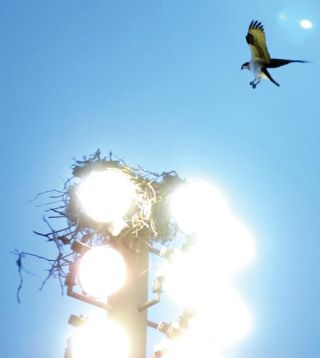It’s hard to miss a bird with a 5-foot wingspan, especially when one is perched on a row of lights surveying the soccer field during a night game at Islander Stadium. Recently, two osprey have been frequenting many high school events, seeing as their nest — which is large enough for a man to stand in — is located on a pole at the north end of the stadium at Mercer Island High School.
After several years of casually observing the birds, a group of maintenance workers and teachers at Mercer Island High School decided to try and get a closer look by installing a camera to monitor their behavior.
“There’s definitely a male and a female,” said Tony Kuhn who works for the school district maintenance and operations group. “But we don’t know if they’ve laid any eggs yet.”
Kuhn is one of the people responsible for getting a camera installed to watch and study the raptors. The same birds have been returning yearly to their nest for the past five years. After wintering in South America, these two raptors make a 4,000-mile flight back to Mercer Island for the summer.
“We’ve talked about getting a camera for several years now, but we finally got the funding,” said Kuhn.
After getting permission from the Department of Fish and Wildlife, the school contracted out a local company, Thermosite, to acquire and install a camera. Harry Leavitt, faculty director of the high school’s Committee to Save the Earth, also spearheaded the camera efforts.
The camera went up in March, when the school district’s electrician was installing fresh light bulbs in the stadium’s flood lights.
“We did it that way so we could fund the equipment more easily,” said Kuhn, referring to the lift that was needed to raise the crew to the top of the light pole.
Now that it’s up and running, the camera is beaming images down to the schools. West Mercer Elementary school is currently streaming images in its library for the students to come in and see, and other locations within the school district’s network
The camera was set up on the light pole just south of the nest, where everyone hoped they’d get a look into the nest, said Kuhn. At first, it was easy to see the entire nest, but now the two osprey have added so many sticks and branches to it, and the nest walls are considerably higher. Kuhn says they’re good at getting nest-building material, even swooping down over the maintenance crew to grab talonfuls of grass clippings.
A nest first appeared at the stadium about five years ago, said Kuhn. The birds return each year and fix the winter damage.
“It took a hit this year with all the wind, but it looks like they repaired it just fine,” said Kuhn.
“We’re new at this,” he said. “So we’re not sure exactly what we’ll see with the cameras yet.”
Hopefully, they’ll see some eggs. Ospreys usually mate for life, returning to their nests in the spring to begin a five-month nesting period.
“So far, it looks like they’re following the schedule pretty closely for mating and nesting,” said Kuhn.
The osprey, sometimes known colloquially as a “seahawk” around the Puget Sound, is a very distinctive bird. It is mainly white, apart from its dark eye mask, with brown flecks. It has long, thin wings and barbed talons. It is an expert at fishing, which explains why it would choose to nest on Mercer Island — an area surrounded by fresh water. Their size alone could lead people to mistake them for eagles, which also nest on the Island, but their mostly white bodies differ from the eagle’s solid brown body and distinctive white head.
The osprey is an endangered species in many parts of the world, including a handful of U.S. states. It is not currently on the federal list of endangered species, but is being watched in order to monitor its status.
The Department of Fish and Wildlife (DFW) hope to potentially add the new camera to their Wild Watch program in the future. There are currently 10 cameras monitoring everything from eagles to elk stationed around the state. The public can view all of these online through the Wild Watch program.
“The cameras are like a magnet,” said Chuck Gibilisco, DFW’s Wild Watch program director. “It’s good content, each camera is a huge encyclopedia of information on a species.”
Each camera currently on Wild Watch gets hundreds of thousands of hits this time of year, Gibilisco said.
“Birds especially are easy to watch by camera because they return to one place [the nest] frequently. The birds are nesting this time of year, so it’s a great time to watch.”
While the MIHS osprey camera is currently only visible on the school district’s network, it’s a good resource for students and teachers studying the birds, and may soon be expanded for a public audience.
On the Web:
Hear the call of an osprey at http://en.wikipedia.org/wiki/Image:Pandion_haliaetus.ogg
See the Wild Watch cameras at http://wdfw.wa.gov/wildwatch



